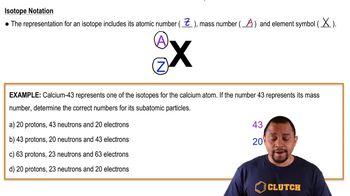Textbook Question
Write isotopic symbols in the form X-A (e.g., C-13) for each isotope. c. the gold isotope with 122 neutrons
 Verified step by step guidance
Verified step by step guidance



Write isotopic symbols in the form X-A (e.g., C-13) for each isotope. c. the gold isotope with 122 neutrons
Write isotopic symbols in the form X-A (e.g., C-13) for each isotope. d. the uranium isotope with 143 neutrons
Write isotopic symbols in the form AZX for each isotope. a. the nickel isotope with 32 neutrons
Write isotopic symbols in the form AZX for each isotope. c. the rubidium isotope with 45 neutrons
Determine the number of protons and the number of neutrons in each isotope. a. 147N
Determine the number of protons and the number of neutrons in each isotope. d. 20882Pb